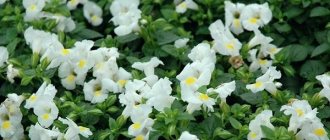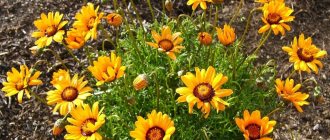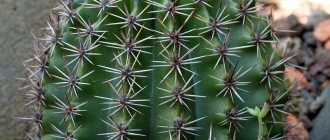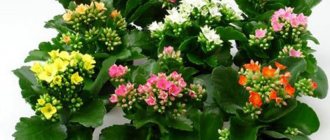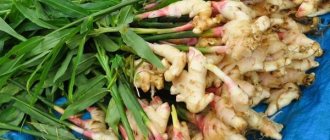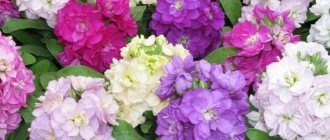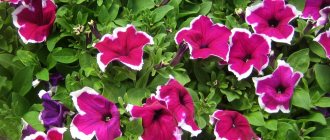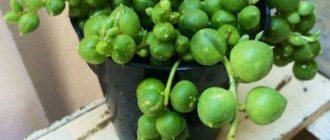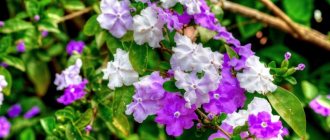When does it bloom?
Ginger flowers leave no one indifferent, so it's worth making some effort to get them.
Under natural conditions, ginger blooms in the second year of the plant's life .
It should be clarified that its rhizome becomes fibrous, loses its aroma and can no longer be used for culinary purposes. Therefore, those who grow ginger for sale do it simply - they dig up the plant after a year. Fortunately, in the warm climate of Southeast Asia, ginger grows and multiplies quickly. You can read about where and how ginger grows in a separate article. When growing ginger in a greenhouse or at home, flowering can occur only in the third year, and then only if the owner complies with a number of requirements of the capricious plant.
As a rule, ginger flowering begins in the spring-summer period and lasts several weeks; with proper care and some luck, flowering will continue until autumn.
Growing ginger at home
If the goal of your experiment is not to obtain a useful root vegetable at home, then when the leaves begin to wilt, provide rest to the ginger by reducing watering. Place the container in a cool, dark place . Moisten the soil regularly . In the spring, when the time comes to “wake up” the flower, begin abundant watering and fertilizing.
In the video you can see how to grow ginger from a root at home:
Be patient. Even in very good conditions, ginger begins to bloom after 3–4 years . But the ginger grown by you from an ordinary root will delight and surprise you and your guests with original, bamboo-like pseudostems made of leaves rolled into a tube up to 1 meter high and bright original foliage, similar to sedge.
This is interesting! Your home will be filled with the aroma of citrus fruits - this is how all parts of the plant smell. The substances it releases, along with the aroma, will also provide protection against germs and bacteria.
The flowering of ginger is truly unique: its bright orange, rich yellow or brown inflorescences are collected in the likeness of a spike at the top of the shoot, decorating the axils of the leaves.
How to determine that this will happen soon?
Ginger flowers are located on long basal stems . Until these stems appear, it is impossible to determine the impending flowering.
The most important sign of impending flowering is the formation of a special bud by the main tuber to push out the peduncle. This kidney must be healthy, grown and developed within the previous three years.
It is quite possible that the main root has already formed root adventitious shoots to prepare the bud for the flowering stalk, but all this careful preparation is hidden underground.
And, if the owner of the plant disrupts the growth of these shoots during transplantation, flowering will not occur - a regular additional stem will grow from the bud instead of a peduncle.
To force a ginger flower, you should be patient and follow all recommendations for caring for the plant, without removing the tubers from the pot for at least three years.
The peduncle will never grow from the body of the tuber that you originally planted in the pot. It will only come out of that part of it that has developed during the subsequent growth of the tuber. And this takes time. That is why ginger blooms only after several years.
How it blooms: description of varieties and photos
There are many varieties of ginger and each blooms differently . The flowering of any type of plant is an unusual sight - ginger produces flowers on long basal stems. One inflorescence can have petals of different shades from red and purple to yellowish. And the shape is surprising - in the form of cones, lilies. It may be a single large flower or several torch-shaped constellations.
Let's consider the most aesthetic and popular varieties of ginger. And further in the photo you can see some of the plant varieties blooming at home and outdoors.
At home
The presented varieties are most often grown at home for decorative purposes.
Zerumbet
Large inflorescences are formed on the stems , outwardly similar to a rose with dense, fleshy petals.
Wonderful
On powerful stems, bright pink inflorescences similar to the cob of corn bloom.
Kasumunar
The flowers are similar to orchids, complex in structure, white in color.
Japanese
Delicate flowers with a pleasant aroma appear in early spring.
Ginger Torch
Pinkish fluffy inflorescences, almost odorless.
Purple
Pinkish fluffy inflorescences , almost odorless.
On the street
Varieties intended for growing in open ground conditions are most often grown for the purpose of obtaining a harvest and were selected for the size and taste of the rhizomes, so they bloom much more modestly. But even among them there are exceptions that give owners the pleasure of enjoying the most beautiful flowers.
Black Ginger (Barbados)
Medium-sized soft pink flowers , shaped like a chamomile, with bright red stamens in the middle. The smell is strong, sweetish.
White Ginger (Bengal)
Large bright scarlet single flowers with a delicate scent.
ginger beehive
Included in the ranking of the most beautiful tropical flowers in the world. The height of the inflorescence reaches one and a half meters, the petals vary from green to bright scarlet. Cultivated in tropical gardens in Southeast Asia , it is not grown at home.
Purchase
When choosing a root to plant, pay attention to its condition. It doesn’t matter where you buy it, in a specialty store, at the market or in the vegetable department of the supermarket, the only condition is that the ginger root must be fresh .
Look out for these signs:
- the skin should be even and smooth;
- the root itself should not be damaged;
- a wrinkled and fibrous piece of rhizome is unlikely to germinate;
- you cannot take frozen ginger;
- there should be several living buds on the root, similar to potato eyes.
Important! To grow ginger from the root at home, before planting, place it in warm water for several hours .
If you have purchased a large enough piece of rhizome with several buds and bridges, you can carefully divide it and try to grow several plants
Flowering and yield
To obtain a good and high-quality harvest of rhizomes, ginger flowering is undesirable. Moreover, in its homeland, in Southeast Asia, ginger is grown only as an annual plant - a rich harvest of tubers is harvested 8-9 months after planting.
Thus, the flowering of the plant, which can only happen in the second year of its life, cannot happen. Only individual bushes on the edge of the plantations manage to bloom if they were accidentally forgotten to dig up. In the wild, ginger is practically never found .
Flowering spoils the taste of the tubers so much that it becomes completely impossible to eat them and makes them dry and fibrous. In addition, the tubers lose their magical smell and taste.
This happens because the plant directs all the nutrients from the roots that have fulfilled their function to the seeds . The seeds are formed at the end of flowering and have the shape of small boxes. At the same time, modern cultivated varieties of ginger cannot reproduce using seeds.
Care tips, harvesting
The unpretentiousness of the spicy plant is known:
- During development, ginger requires good soil and air moisture, especially during hot periods. Watering should be alternated with loosening the soil around the plantings. It should be shallow, but thanks to the procedure, the growth of shoots will accelerate.
- It is better to spray the leaves of the flower in the evening so as not to expose them to burns.
- Ginger has a positive attitude towards fertilizers, delighting in the future with a good harvest. Mullein diluted with water in a ratio of 1:10 is suitable as a top dressing, alternating the application of mineral fertilizers - potassium salt, superphosphate.
Digging up the roots of the spice begins after the foliage has completely turned yellow and fallen off. The rhizomes are cleared of soil and dried for a week outside under a canopy.
Proper storage of roots involves placing them in a refrigerator or basement, where the temperature should not exceed 2-4 degrees Celsius.
Fresh ginger can be used for up to eight weeks. The product can be frozen, so it can be used longer. Chopped fresh ginger is suitable for preparing alcohol tinctures that will be needed in compresses and rubs. After covering the crushed root with sugar, the mixture is used to brew tea, prepare desserts, and drinks.
You can also dry ginger, then it can retain its beneficial properties for a long time. All that remains is to add a pinch of spice to tea, soup, salads, and main courses. The piquancy of food with ginger has been known since ancient times and enjoys well-deserved popularity.
Does the plant need help?
Yes, if the goal is flowering. In this case, there can be no guarantees, but the owner, of course, must do what is in his power, since the plant is exotic and poorly adapted to our growing conditions.
How exactly?
With the help of fertilizers
If the purpose of growing ginger is flowering, it should definitely be fertilized . It is recommended to fertilize no more than twice a month with fertilizers high in potassium and phosphorus. They will help to obtain powerful greenery and will stimulate the forcing of the peduncle.
As an organic fertilizer, mullein diluted with water in a ratio of 1:10 works well, but for obvious reasons it can only be used in a greenhouse or at least on a balcony.
Initially, the soil for growing ginger should be chosen loose, nutritious , consisting of one third humus, one third turf soil and one third sand. A drainage layer at least 3 cm thick is also required, otherwise the roots will rot.
Create optimal conditions
- Avoid exposure to wind and sunlight. The light must be rarefied. The place for the pot must be carefully chosen, since this plant does not tolerate drafts and scorching sun.
- Regularly spray the plant with soft, settled water at room temperature.
- Water moderately at the first signs of drying out of the top layer of soil, loosen each time after watering to ensure oxygen access to the roots.
- In autumn, reduce the number of waterings to once every 2 weeks, put the pot in a dark, cool (+15 degrees) place.
- In the spring, when the buds wake up, take the pot out of the basement and begin to water it in small portions, adding fertilizers: first potassium for the growth of greenery, then phosphorus for the formation of flower stalks.
If ginger is grown for decorative purposes, you need to choose a small pot and not disturb the roots for at least three years, including not digging it up for the winter and not replanting it.
You can find out more information about this wonderful plant in our articles. Read about the difference between ginger and horseradish, how to store it correctly, how it is useful in dried form, and whether it can be given to children.
Thus, we talked about the amazing ginger and showed photographs of the plant in bloom. But growing ginger for decorative purposes in Russia is a risky activity in terms of results - after all, our climate is not warm and humid enough. However, with excellent care and a certain amount of luck, there is a chance to enjoy the wonderful spectacle of the flowering of this amazing plant. If a capricious pet does not want to bloom, then in any case it will delight the owner with the spicy aroma of a fresh, juicy root.
If you find an error, please select a piece of text and press Ctrl+Enter.
Ginger flower - a unique decoration for your home
A treasure trove of beneficial substances is the rhizome of an Asian spice. But many gardeners grow ginger for its flowers. They are proud when a miracle of nature blooms, surprising and delighting those around them. There are varieties that have very beautiful inflorescences with a pleasant delicate aroma.
But seeing ginger in bloom is rare. Only an adult plant has this property. It needs special care and patience.
There is no need to dig up the root for the winter. Make sure that the soil is slightly moist in winter. Every season, during active growth, feed the plant with additives that contain potassium. These additives are used to feed decorative and not vegetable crops.
If you give enough attention and time to the Asian spice, then after about three years (or maybe more) you will be pleased with the flowering.
